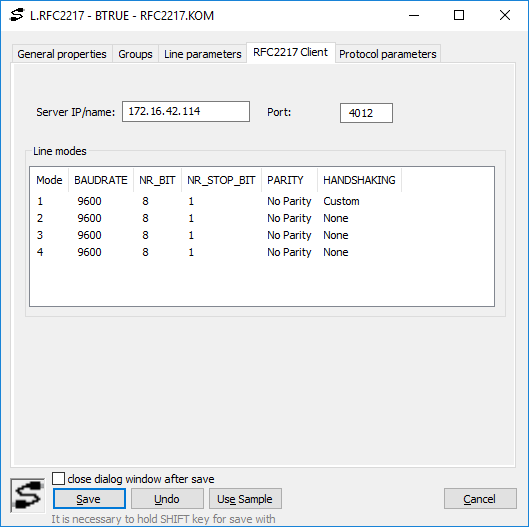...
The "RFC2217 Client" communication line supports the communication with the converters of serial interfaces (device servers) according to the RFC2217 (Telnet Com Port Control Option) standard. It supports a transfer of data and control commands (setting baud rate, number of bits, parity, etc.) over a single TCP connection (NVT - Network Virtual Terminal).
Unlike the "SerialOverUDP Device Redundant" and "SerialOverUDP Line Redundant" lines, the transmission parameters may be set remotely, i.e. from the configuration of the line in the D2000 System. The line of the "RFC2217 Client" category can be used on both Windows and Linux platforms.
Both IPv4 and IPv6 protocols are supported.
Parameters
...
Configuration parameters of of the "RFC2217 Client" line.
Server IP/name
...
Transmission parameters can be set for four modes, as when setting the "Serial" and "Serial Line Redundant" lines.
Parameter "ConstOpen"
The meaning of the "ConstOpen" parameter is different from the serial line. The is ignored - TCP connection is established the first time it is used.when the line is used for the first time and remains established (except for behavior in redundancy - see Operation of the line in redundancy).
If "ConstOpen" is checked for Line mode 1, when establishing a connection the KOM process waits for responses to all RFC2217 queries. If all responses are not received, the connection is closed.
If "ConstOpen" is unchecked for Line mode 1, when establishing a connection the KOM process does not wait for responses (except for the response to the initial WILL CPO, which detects RFC2217 support), so the connection will also work against servers that ignore some of the queries.
If "ConstOpen" is unchecked for Line mode 2, when establishing a connection the KOM process does not wait for the response to the initial WILL CPO, which detects RFC2217 support.
The following RFC2217 parameters are queried when establishing a connection:
- SIGNATURE (device identification, eg "MOXA").
- BAUDRATE (speed, eg 9600 baud)
- DATASIZE (number of bits, eg 8)
- PARITY (parity, e.g. even/odd)
- STOPSIZE (number of stop bits)
- signal states - BREAK, DTR, RTS, flow control (XON / XOFF, hardware, DCD, DTR, DSR)
and the following RFC2217 parameter is set:
- LINESTATE (setting of line status reporting - e.g. timeout error, framing error, parity error, overrun error, break-detect error)
| Kotva | ||||
|---|---|---|---|---|
|
In redundant systems (redundant D2000 servers and/or multiple instances of KOM processes), only the active KOM process connected to the D2000 Server in the HOT state opens a TCP connection. Once it becomes passive, the connection to the device is closed.
...
The tell command LNSTAT OPEN/CLOSE stops communication (CLOSE) and closes the connection to the device. Communication resumes after the LNSTAT OPEN command or when the communication process is restarted.
| Info | ||
|---|---|---|
| ||
You can also read the blog about the RFC2217 line: |
| Info | ||
|---|---|---|
| ||
...
